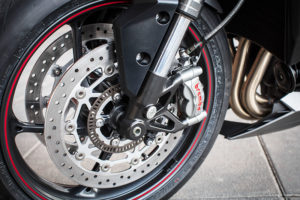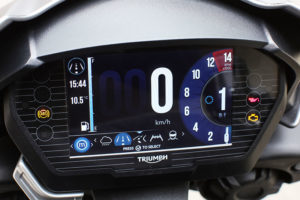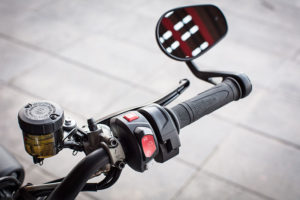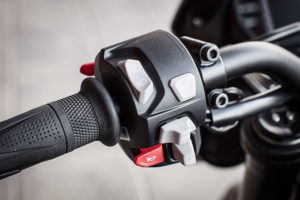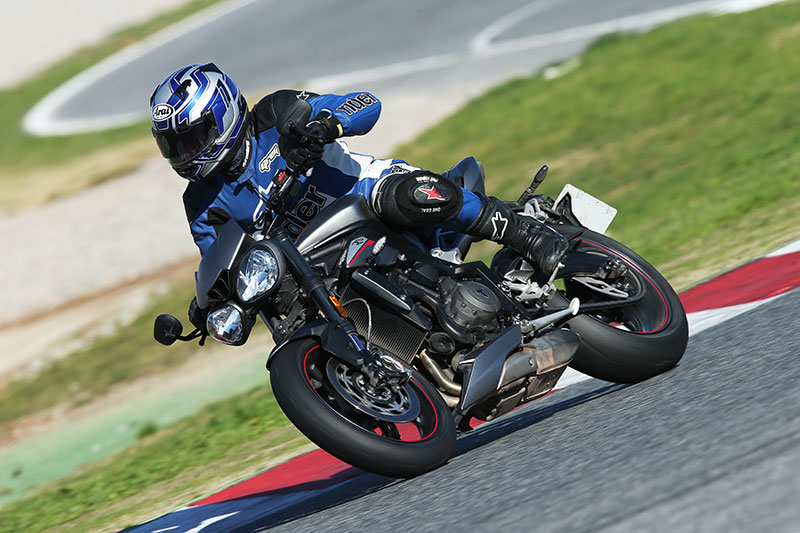
Within Triumph’s robust motorcycle lineup, no fewer than eight models have one or more of the following four words in their name: Speed, Street, Triple and Twin. In the Modern Classics family, there’s the Street Cup, Street Scrambler and Street Twin, and there’s a cruiser called the Speedmaster, all of which have parallel twins. And then there are the roadsters, powered by in-line triples: Street Triple S, Street Triple R, Street Triple RS and Speed Triple S.
The Street Cup café racer and Street Scrambler are new for 2017, and you can read our reviews of them by clicking on the links below.
Read our 2017 Triumph Street Cup review
Read our 2017 Triumph Street Scrambler review
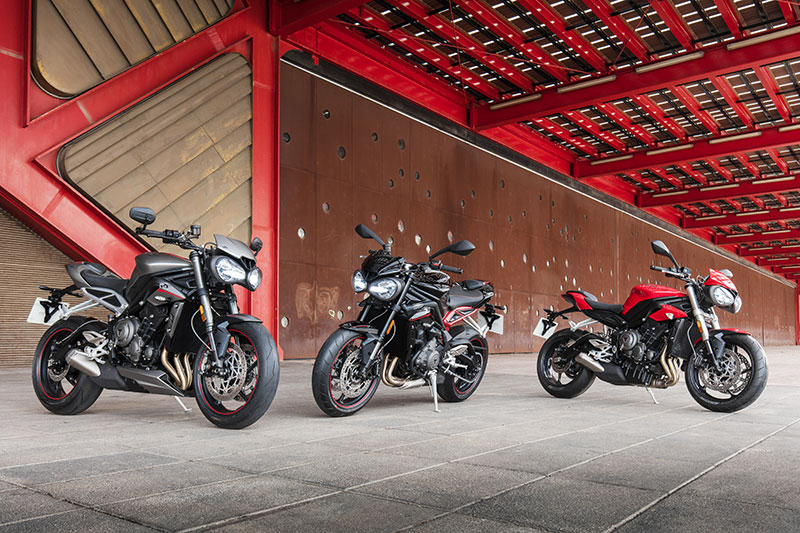
For the past few years, the only Street Triple model was the Street Triple R. For 2017, there are three versions—S, R and RS—with quite different levels of specification and prices ranging from $9,900 for the S to $12,500 for the RS. What they have in common are the same larger, 765cc in-line triple (up from 675cc thanks to a larger bore and longer stroke), the same aluminum twin-spar frame and aluminum gullwing-shaped swingarm, the same cast-aluminum, five-spoke, 17-inch wheels and the same claimed dry weight, 366 pounds, which is about 4 pounds lighter than last year’s model.
But they differ in terms of engine output, electronics, geometry, componentry, instrumentation and more. Listing all of those differences in detail would make this a very boring review to read. At the world press launch near Barcelona, Spain, the only bike we rode was the top-of-the-line RS, so that’s the focus of this review. To find out more about how the S and R differ from the RS, visit Triumph’s website.
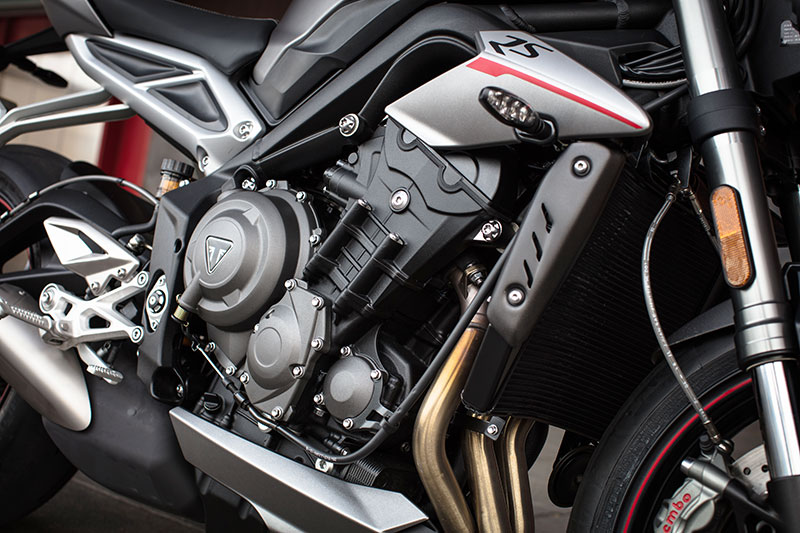
Triumph’s sporting triples, including variations of the Daytona 675, Street Triple and Speed Triple, have always been thrilling bikes to ride. The in-line three-cylinder engine is an uncommon configuration, one that provides a unique combination of sound, torque and feel that has consistently won over the hearts of Rider staffers. When we last tested a Street Triple R, in a comparison test with the BMW F 800 R and Ducati Monster 796, Editor-in-Chief Tuttle described the spunky little Brit bike as follows:
“[T]he best-engine award goes to the Triumph, which is smooth from idle to redline and revs powerfully and cleanly with an awesome snarl and near-perfect delivery…The triple is just fine being short-shifted and ridden from stoplight-to-stoplight around town or cruising down the highway, with a torque curve so flat it’s more like a table. Yet when racer road beckons, the bike’s 97 horsepower at the rear wheel more than satisfy—they flat scream.”
Read our 2011 Triumph Street Triple R vs BMW F 800 R vs Ducati Monster 796 comparison review
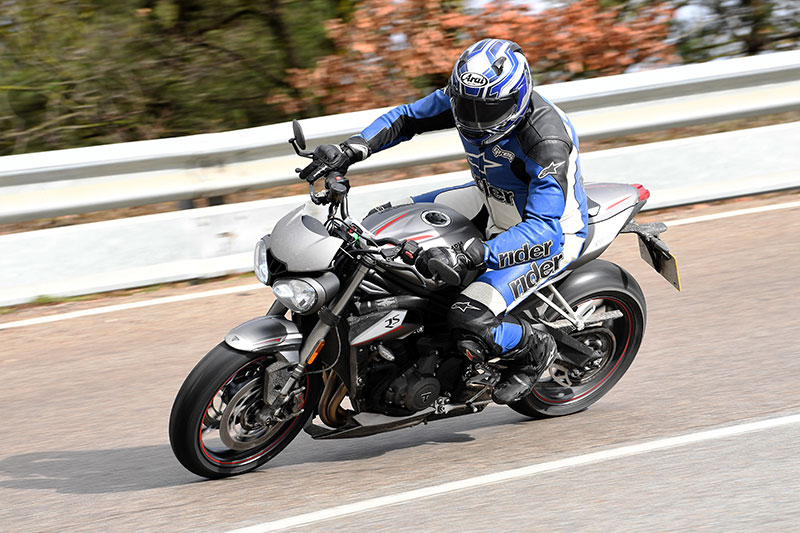
What was really good is now even better. Thanks to its increased displacement and 80 new parts (including a new crankshaft, pistons, con rods, Nikasil-plated aluminum barrels and balancer shaft), the Street Triple RS churns out more horsepower and torque throughout the rev range (claimed peak figures at the crank are 121 horsepower at 11,750 rpm and 56.8 lb-ft of torque at 10,800pm). Calibration of the new throttle-by-wire is so spot-on that its response is even closer to perfection, and there are now five riding modes. A new airbox cranks up induction roar during acceleration and a new exhaust pumps out even richer sound of music. Not only that, but shorter first and second gear ratios give it more snap off the line, new transmission geometry and an assist-and-slipper clutch make already-slick gear changes even smoother and an oh-so quickshifter is now standard.
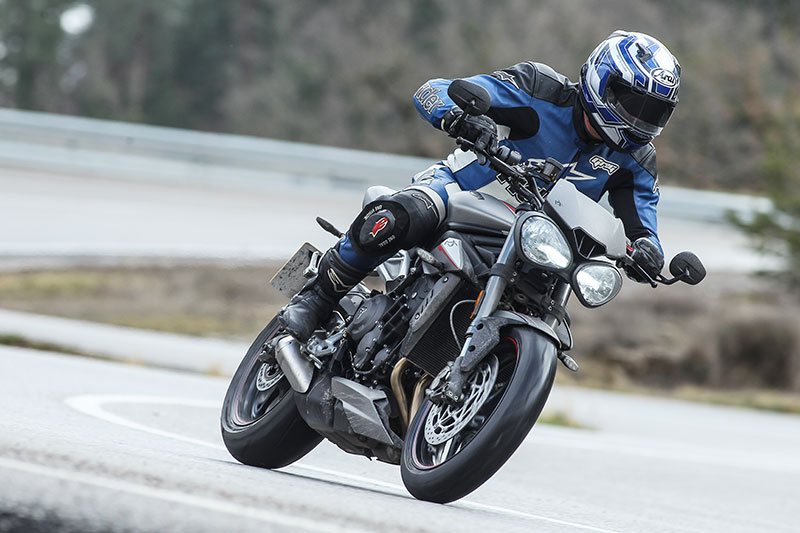
Our test ride included about 100 miles on the street and three track sessions at one of Spain’s preeminent temples of speed, Circuit de Barcelona-Catalunya, a popular stop on the MotoGP calendar. When our morning street ride began, it was about 50 degrees outside and hours of overnight rain had just ended. The bikes were fitted with barely scrubbed-in Pirelli Diablo Corsa SP tires and—thankfully—accessory heated grips. Our pace was appropriate for the conditions, and due to wet spray from the road, the bikes and our riding gear were caked with sand and dirt by the time we stopped for a midmorning café solo. Turned out to be an ideal time to test Rain mode, which tones down throttle response and ramps up ABS and traction control sensitivity. The RS doled out power and handled in a predictable manner, and the Pirellis provided better than expected wet grip.
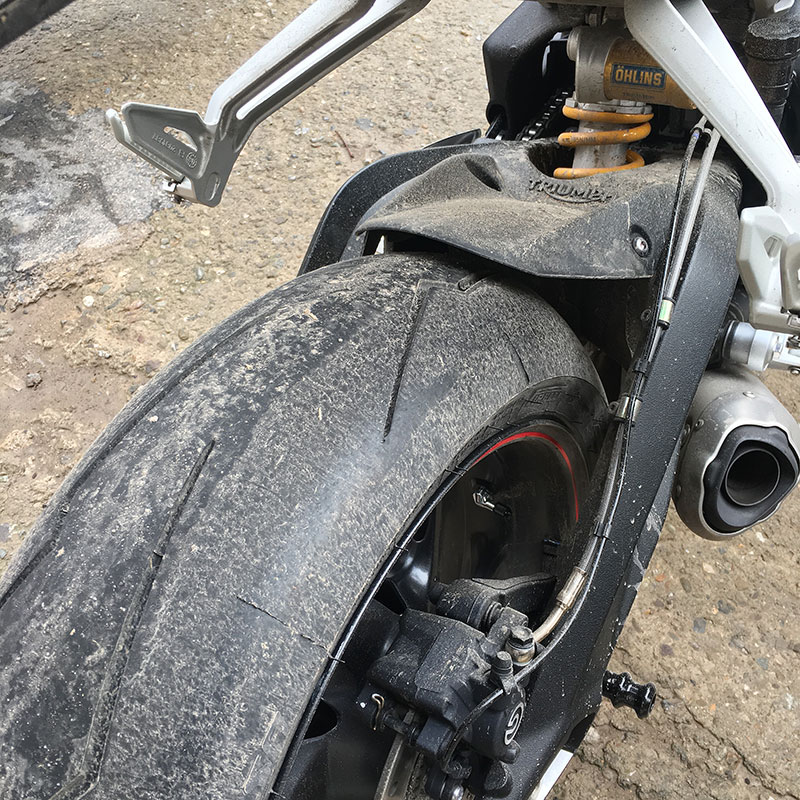
As the road began to dry out later in the morning, we wicked it up more and I switched over to Road and then Sport mode. Throttle response became quicker with each new mode, but it was never abrupt or unnecessarily aggressive. With its wide, upright handlebar, tidy steering geometry and light weight (actual wet weight should be about 417 pounds), the RS turns telepathically, and the nicely rounded profile of the Pirellis roll into turns gracefully. Some may find the 32.5-inch seat height off-putting, but it suited my rangy frame just fine, and I have no complaints about the fairly upright riding position. Although I hadn’t been on a Street Triple in six years, I felt right at home on the RS despite the somewhat sketchy conditions. Triumph does a great job with styling and performance, but perhaps its greatest unsung virtue is the baked-in user-friendliness that characterizes many bikes in its lineup.
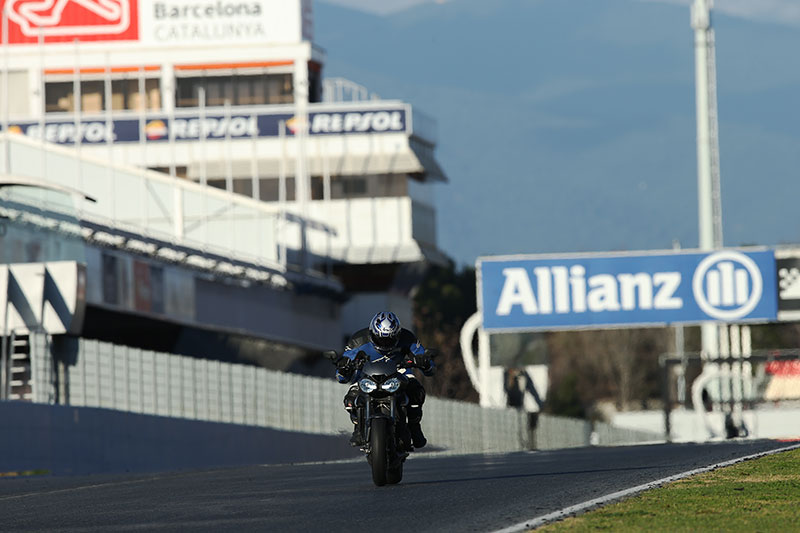
My sense of comfort and confidence only became stronger as we moved onto the track, which, admittedly, isn’t the environment where I feel most comfortable. Fortunately, Catalunya is a nicely flowing circuit without any weird corners designed to trip you up (though the new, squared-off chicane just before the front straight is painfully slow and awkward). Tire warmers kept the rubber at just the right temperature between sessions, and switching over to Track mode used the same right-now throttle map as Sport mode but dialed ABS and traction control way back (there’s also a customizable Rider mode). I was much more aggressive with the throttle and brakes, but the RS never got out of shape, and it never threatened to teach me a painful lesson.
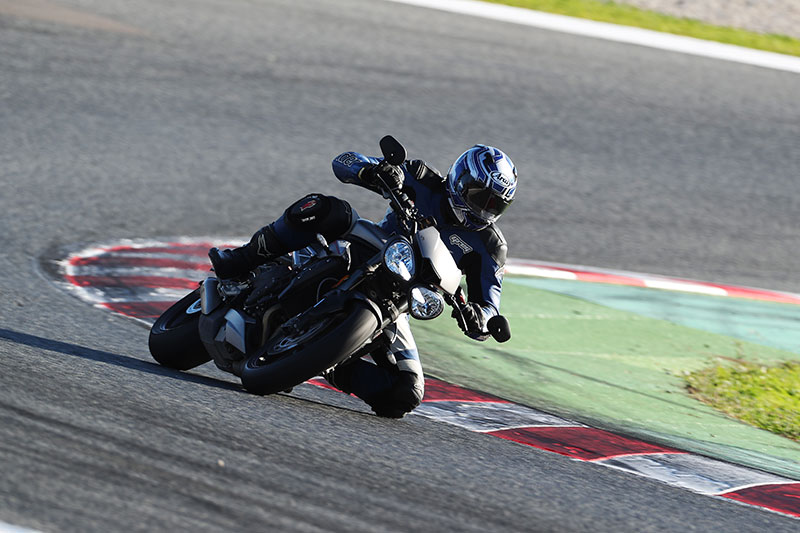
A big part of what keeps the RS on its best behavior is a dream team of components, including a Showa Big Piston Fork and Öhlins STX40 piggyback reservoir shock, both fully adjustable, top-of-the-line Brembo M50 monoblock radial 4-piston front calipers and the aforementioned Pirelli Diablo Corsa SP tires, which are track-ready but street-legal. Every ripple of pavement was dispensed with masterfully, and those Brembo binders are revelatory. A nice touch is the Brembo MCS brake lever that is not only adjustable for reach (like the clutch lever), but also has a three-position ratio adjuster that changes the amount of pull required.
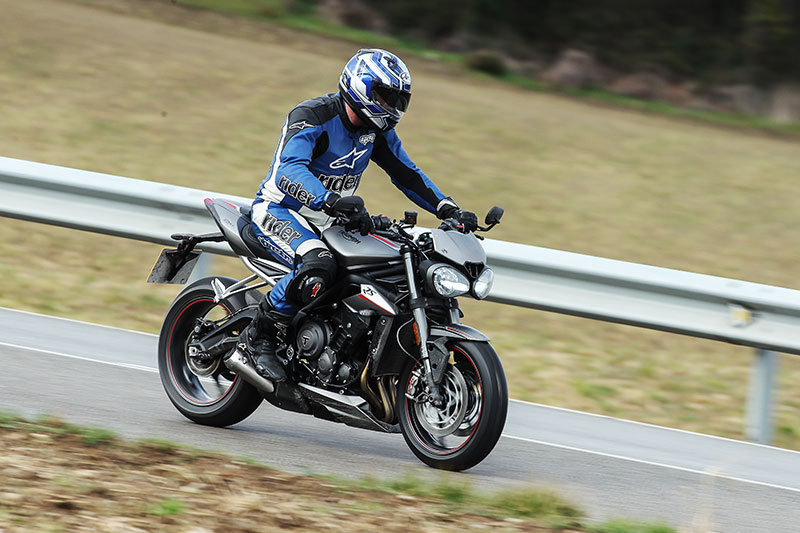
Triumph could have made all of the engine and chassis improvements and done nothing else and still had a winner on its hands, but it also gave the Street Triple more aggressive styling (similar to its big brother, the Speed Triple), a new dual seat that’s wide and reasonably comfortable, a host of cool styling details, new switchgear and one of the most eye-catching, comprehensive and customizable full-color TFT instrument panels I’ve ever seen.
Read our 2016 Triumph Speed Triple R review
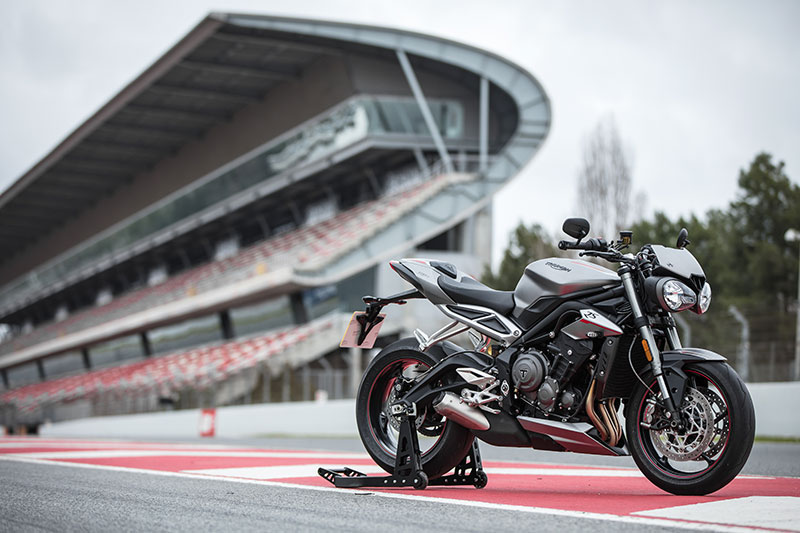
Based on my short time aboard the Street Triple RS, I’ve struggled to find anything about the bike that I don’t like. The small flyscreen provides minimal wind protection, but I can’t fault a naked bike for being naked. I’ve always liked the Speed/Street Triple’s bug-eyed styling, and the RS doesn’t want for performance. Its 765cc triple is just about perfect in terms of size and output—enough for a hair-on-fire 140 mph down the front straight of Catalunya, but not so powerful or aggressive that I ever feared, at the slightest provocation, the thing would fling me off. Build quality and component choice are first-rate on the RS and you get a lot of bike for the money, but if $12,500 busts the budget, there are two lower-spec, lower-priced models to choose from (and there’s even a Low Ride Height (LRH) version of the R that’s the same price, $11,200, with a 30.7-inch seat height). More seat time on the street, especially in more agreeable conditions, may reveal some warts, but for now I’ll just tip my hat to the folks in Hinckley. Well done, mates.
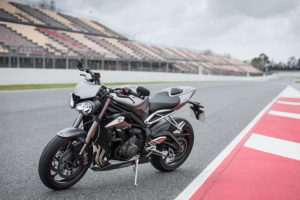
2017 Triumph Street Triple RS Specs
Base Price: $12,500
Website: triumphmotorcycles.com
Engine Type: Liquid-cooled, transverse in-line triple, DOHC w/ 4 valves per cyl.
Displacement: 765cc
Bore x Stroke: 78.0 x 53.4mm
Transmission: 6-speed, cable-actuated assist-and-slipper wet clutch
Final Drive: O-ring chain
Wheelbase: 55.5 in.
Rake/Trail: 23.9 degrees/3.9 in.
Seat Height: 32.5 in.
Claimed Dry Weight: 366 lbs.
Fuel Capacity: 4.6 gals., last 1.0 gal. warning light on
Claimed MPG: 50 (EPA estimate)
